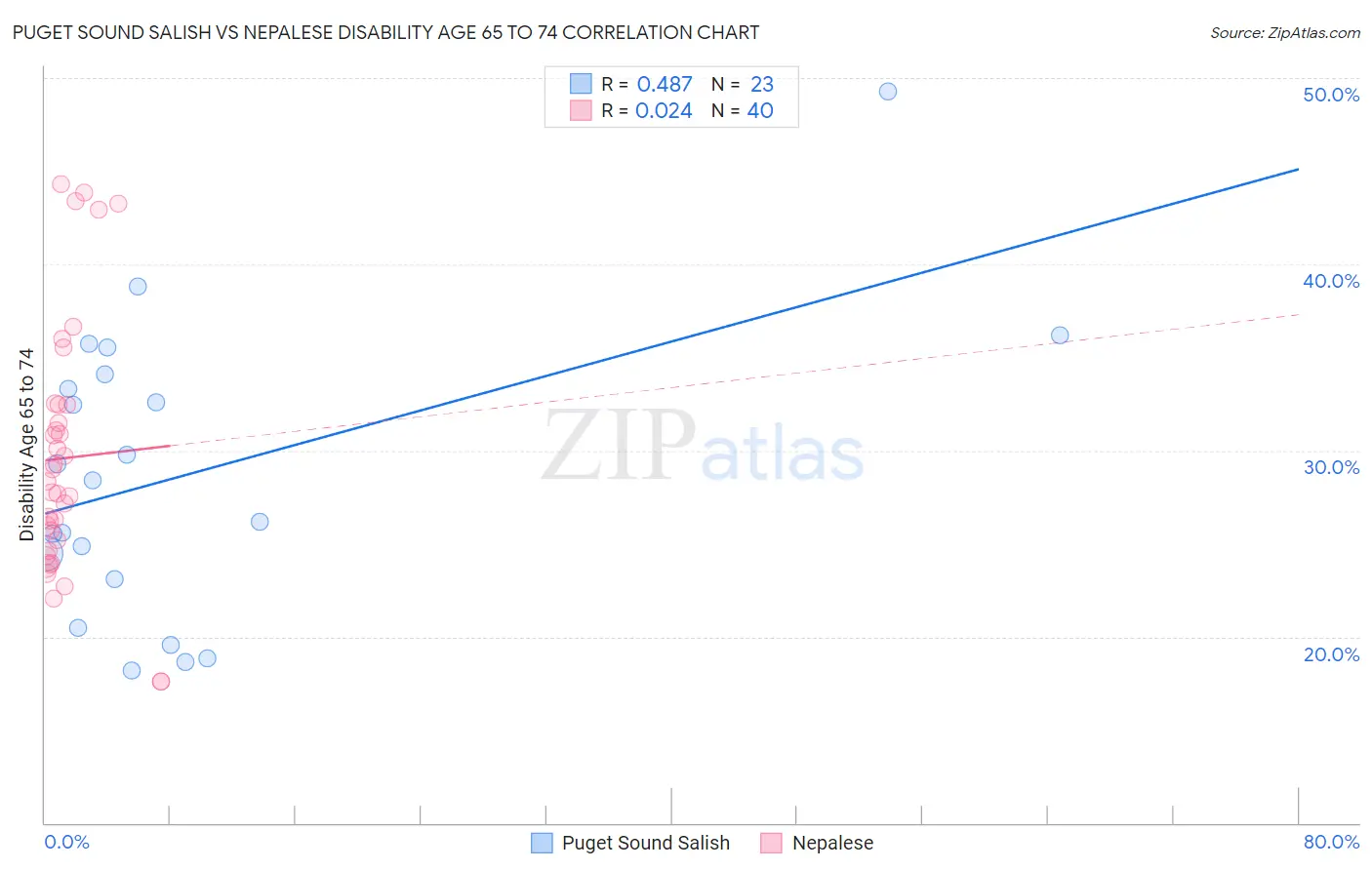Puget Sound Salish vs Nepalese Disability Age 65 to 74
COMPARE
Puget Sound Salish
Nepalese
Disability Age 65 to 74
Disability Age 65 to 74 Comparison
Puget Sound Salish
Nepalese
27.2%
DISABILITY AGE 65 TO 74
0.0/ 100
METRIC RATING
304th/ 347
METRIC RANK
28.0%
DISABILITY AGE 65 TO 74
0.0/ 100
METRIC RATING
318th/ 347
METRIC RANK
Puget Sound Salish vs Nepalese Disability Age 65 to 74 Correlation Chart
The statistical analysis conducted on geographies consisting of 46,105,996 people shows a moderate positive correlation between the proportion of Puget Sound Salish and percentage of population with a disability between the ages 65 and 75 in the United States with a correlation coefficient (R) of 0.487 and weighted average of 27.2%. Similarly, the statistical analysis conducted on geographies consisting of 24,503,622 people shows no correlation between the proportion of Nepalese and percentage of population with a disability between the ages 65 and 75 in the United States with a correlation coefficient (R) of 0.024 and weighted average of 28.0%, a difference of 3.2%.

Disability Age 65 to 74 Correlation Summary
| Measurement | Puget Sound Salish | Nepalese |
| Minimum | 18.2% | 17.6% |
| Maximum | 49.3% | 44.3% |
| Range | 31.1% | 26.7% |
| Mean | 28.7% | 29.6% |
| Median | 28.4% | 28.1% |
| Interquartile 25% (IQ1) | 23.1% | 24.9% |
| Interquartile 75% (IQ3) | 34.1% | 32.4% |
| Interquartile Range (IQR) | 11.0% | 7.5% |
| Standard Deviation (Sample) | 7.7% | 6.8% |
| Standard Deviation (Population) | 7.5% | 6.7% |
Demographics Similar to Puget Sound Salish and Nepalese by Disability Age 65 to 74
In terms of disability age 65 to 74, the demographic groups most similar to Puget Sound Salish are Mexican (27.2%, a difference of 0.10%), Tlingit-Haida (27.1%, a difference of 0.12%), Central American Indian (27.1%, a difference of 0.18%), Immigrants from Mexico (27.1%, a difference of 0.19%), and Black/African American (27.3%, a difference of 0.50%). Similarly, the demographic groups most similar to Nepalese are Immigrants from Armenia (28.0%, a difference of 0.22%), Arapaho (28.1%, a difference of 0.23%), Crow (27.9%, a difference of 0.31%), Cajun (27.9%, a difference of 0.35%), and Cherokee (28.2%, a difference of 0.62%).
| Demographics | Rating | Rank | Disability Age 65 to 74 |
| Immigrants | Mexico | 0.0 /100 | #301 | Tragic 27.1% |
| Central American Indians | 0.0 /100 | #302 | Tragic 27.1% |
| Tlingit-Haida | 0.0 /100 | #303 | Tragic 27.1% |
| Puget Sound Salish | 0.0 /100 | #304 | Tragic 27.2% |
| Mexicans | 0.0 /100 | #305 | Tragic 27.2% |
| Blacks/African Americans | 0.0 /100 | #306 | Tragic 27.3% |
| Ute | 0.0 /100 | #307 | Tragic 27.3% |
| Sioux | 0.0 /100 | #308 | Tragic 27.3% |
| Yaqui | 0.0 /100 | #309 | Tragic 27.4% |
| Shoshone | 0.0 /100 | #310 | Tragic 27.4% |
| Menominee | 0.0 /100 | #311 | Tragic 27.4% |
| Osage | 0.0 /100 | #312 | Tragic 27.5% |
| Paiute | 0.0 /100 | #313 | Tragic 27.8% |
| Chippewa | 0.0 /100 | #314 | Tragic 27.8% |
| Cajuns | 0.0 /100 | #315 | Tragic 27.9% |
| Crow | 0.0 /100 | #316 | Tragic 27.9% |
| Immigrants | Armenia | 0.0 /100 | #317 | Tragic 28.0% |
| Nepalese | 0.0 /100 | #318 | Tragic 28.0% |
| Arapaho | 0.0 /100 | #319 | Tragic 28.1% |
| Cherokee | 0.0 /100 | #320 | Tragic 28.2% |
| Comanche | 0.0 /100 | #321 | Tragic 28.3% |